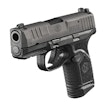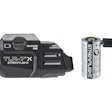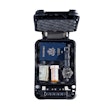Most officers who carry Glock pistols will know exactly what I mean when I say that the new Glock G21SF is "...just a Glock." But such flippancy should in no way be taken as a negative comment because one of the line's most positive features is that once you know how to use one Glock, you know how to use all of them.
For decades now Glock pistols have been available in two frame sizes: "small" frame guns chambered for the 9mm, .40 S&W, .357 SIG, and .45 GAP, while those chambered for the 10mm and .45 ACP cartridges were assembled on the "large" frame. Ever since their introduction, the latter have been criticized by some because they are...well, they're large. Those officers who do not have large hands often find it difficult to obtain a secure purchase on large-frame Glocks, while others must shift the pistol around in their hands in order to manipulate the magazine release and/or slide stop.
Ever since American police forces began switching from revolvers to semi-auto pistols in the 1980s, there has been a controversy over the cartridges they have been chambered for. While 9mm Parabellum was the original choice of most departments, street officers soon began asking for a more powerful round, yet they wanted it in a pistol that was also light enough to carry comfortably all day whether in a holster or concealed. The .40 S&W and .357 SIG rounds provided more punch, but there was still a significant number of agencies and officers who wanted bigger bullets.
It is a well-known fact that most American handgun shooters — LEO and civilian — have had a long love affair with .45 caliber handguns. Glock sought to address this market with its G21 pistol firing the .45 ACP cartridge. But as I said at the beginning of this report, the G21 can be quite a handful.
Glock received enough requests for a .45 pistol of manageable size that it introduced the G37 chambered for the .45 GAP cartridge. The .45 GAP provided .45 ACP-like ballistics from a pistol built on the company's small frame. While the G37 has become moderately popular in law enforcement circles, the fact remains that when it comes to .45 pistols, most officers want the real thing, a .45 ACP pistol.
Keeping in mind the old adage that "the customer is always right," Glock sent its engineers back to their CAD programs. And they came up with a rather simple solution. Reducing the size (depth) of the large frame's backstrap resulted in a trigger reach of 2.87 inches as opposed to the 2.95 on a standard large-frame Glock. The new pistol was dubbed, appropriately enough, the G21SF or Glock Model 21 "Short Frame."
But the smaller frame is not the only thing that makes the G21SF unique: It is also the first Glock pistol to feature ambidextrous magazine release catches.
Pressing either of the G21SF's magazine catches pivots a wedge in the front of the magazine well forward, allowing the 13-round magazine to drop free. Other than the fact that G21SF magazines have their locking notch on the front of the body, they are identical to those used in the G21. In fact, Glock now only manufactures one magazine with two locking notches for use in either pistol.
Another nice feature is that the G21SF can be ordered with either a standard frame rail, allowing the use of Glock Tactical Lights, or a NATO standard Picatinny rail capable of accepting most types of lights, laser sighting devices, and other accessories.
Glock provided me with a G21SF to evaluate for POLICE. Here are some of my impressions.
I have owned several G21 pistols over the years. At first glance, the G21SF appears identical to all other G21 pistols. But as soon as I picked it up, the difference in grip size was immediately apparent. The pistol just felt more "secure" in my hand and the magazine release and slide stop were easily manipulated with my shooting hand thumb. I also didn't have to move the pistol around in my hand to reach them.
At the range, I set up a series of targets and proceeded to run five different brands of high-performance .45 ACP ammo through the new Glock. Look at the attached chart and photos, and you will see that while it shot to point of aim with all five loads, it showed a definite preference for heavier bullets.
I then ran a series of drills on a pair of D-1 targets at ranges of seven and 15 yards with the G21SF and a standard G21, firing both supported and unsupported (one handed). Afterward, both pistols were run through timed, speed drills on steel targets, and I always managed to "ring" them a bit faster with the G21SF. As I said above, while I have had a lot of experience with the G21, I found its slimmer cousin provided enhanced ergonomics and recoil control and allowed faster follow-up shots.
While both the G21 and G21SF proved to be fine handling pistols, if it were up to me to choose one of them, my vote would go to the SF. The G21SF is adaptable to a much wider variety of hand sizes and has enhanced ambidextrous qualities, both of which should be of prime importance when choosing a service pistol.
But I wanted to get some opinions of officers who currently carry the G21. So I showed the new Glock to several members of the Randolph County (N.C.) Sheriffs Office. Their present issue pistol is the G21 and, while generally popular, there have been complaints voiced by some of the personnel regarding the size of the grip. The officers who examined the G21SF found it a very attractive item and I heard several comments along the lines of "Now, where do we find the funding?" The weapon was particularly attractive to deputies who had small hands or were southpaws.
In the future I hope to see ambidextrous magazine releases on other Glock pistols. Their lack of external, manual safety devices is one of the features that have long made Glock pistols so popular with lefties, and the ambidextrous magazine releases makes them even more suitable for officers who shoot from the port side.














